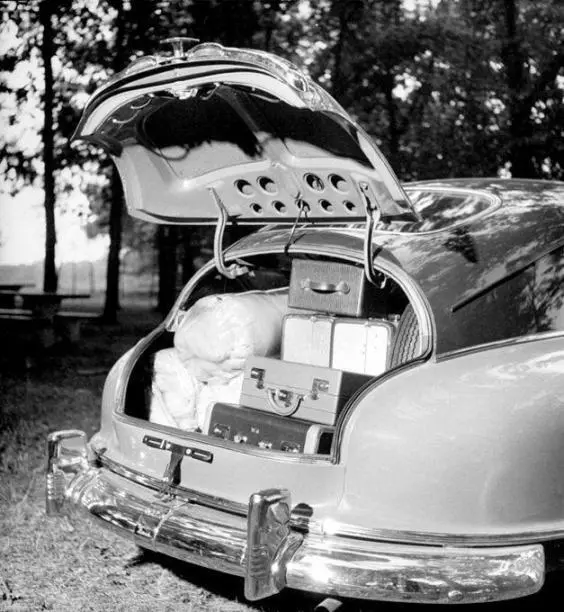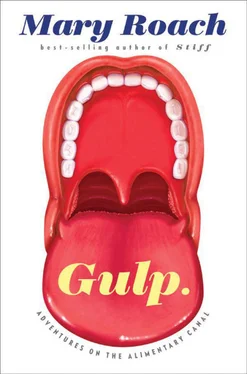11. Up Theirs
THE ALIMENTARY CANAL AS CRIMINAL ACCOMPLICE


SHOULD CIRCUMSTANCE PREVENT a man from carrying his cigarettes and cell phone in his pants pocket, the rectum provides a workable alternative. So workable that well over a thousand pounds of tobacco and hundreds of cell phones are rectally smuggled into California state prisons each year. The contraband allows incarcerated gang members and narcotics dealers to make business calls from behind bars (and to enjoy a smoke while doing so).
“This came in on Friday.” Lieutenant Gene Parks is a contraband interdiction officer at Avenal State Prison. He is making reference to a clear plastic garbage bag two-thirds full with what appear to be but are not yams. They are plugs of Golden Leaf pipe tobacco, sheathed in latex and tapered at one end for ease of insertion, and not into pipes. The garbage bag is a “drop”—bulk contraband—that was hidden on the nearby chicken farm where two to three hundred Avenal inmates commute from the prison to work. Had Parks’s team not gotten to the bag first, the plugs would have been “keistered” by convicts into the prison yard, two or three and occasionally six at a time, and then laid like the eggs the men spend their days with.
A fruity tobacco smell has leached through the plastic. The Investigative Services Unit smells like a tobacconist’s shop. A one-pound bag of Golden Leaf tobacco retails for around $25. On the Avenal yard, an ounce sells for as much as $100, putting the yard value of that $25 bag at $1,600. The penalty, should you get caught, is mild—a temporary loss of visitor privileges. “We’ve disposed of, maybe, in the hundreds of thousands of these,” says Parks. Lieutenant Parks has wide, voltaic blue eyes and a flat, imperturbable speaking manner. The combination makes him seem at once jaded and amazed.
Parks takes me into a storage room and shows me a bank of a dozen small square lockers, one for each month’s contraband cell phones.
“All of these,” I ask, “were…”
“Hooped?” Parks forms a circle with his thumb and forefinger. As in, through the hoop. More slang for rectally imported. “Not all. Some.”
Parks takes two steps and reaches for another large plastic bag. “This is all chargers.” Other bags and boxes contain batteries, earbuds, SIM cards. The slang for the rectum is “prison wallet,” but it could be “Radio Shack.” On the way here, I stopped in the office of a block captain who wanted to tell me about an inmate who was caught with two boxes of staples, a pencil sharpener, sharpener blades, and three jumbo binder rings in his rectum. He became known as “OD,” for Office Depot . They never found out what he intended to do with the stuff.
• • •
THE HOOPERS OF Avenal use the rectum for the basic purpose for which it evolved: storage. The nether distances of the gastrointestinal tract are a holding chamber for what remains of a meal once the intestine has absorbed what it can of the nutrients. Water is absorbed from the digesta as it travels along, and if all goes optimally, it leaves the body around the time it’s reached a manageable water content: somewhere between 2 on the Bristol Stool Scale [66] Available in four languages, with minor modifications.The Portuguese edition, for instance, makes a distinction between the sausage of Types 2 and 3 (referred to as linguiça , a fatter German-style product) and that of Type 4, which is compared to salsicha (the more traditional wiener). The Bristol scale is, after all, a communication aid for physicians and patients. The more specific phrasing was undertaken “for better comprehension across Brazil.”
(“sausage-shaped but lumpy”) and 5 (“soft blobs with clearcut edges”). The lovely upshot is that one need only attend to the emptying once or twice a day.
If you’ll allow it, a closer look at the process. Six to eight times a day, unbeknownst to your thinking, feeling self, a peristaltic muscle contraction called a mass movement squeezes the contents of the colon farther along. Eating reliably triggers this, via something called the gastrocolic reflex. The bigger the meal, the more vigorous the push. Any older detritus that had been parked outside the rectum now gets loaded inside. In with the new, out with the old. “It’s a defensive reflex,” explains William Whitehead, [67] In a more perfect world, Whitehead would be a dermatologist, just as my gastroenterologist is Dr. Terdiman, and the author of the journal article “Gastrointestinal Gas” is J. Fardy, and the headquarters of the International Academy of Proctology was Flushing, New York.
co-director of the Center for Functional Gastrointestinal and Motility Disorders at the University of North Carolina. It prevents the colon from bursting.
When a load pushes against the rectum walls with sufficient pressure—as measured by stretch receptors—the defecation reflex is triggered. (You can trigger it prematurely by bearing down; this raises the pressure on the rectum walls to the requisite level.) The defecation reflex causes the rectal wall muscles to contract—that is, squeeze— at the same time the anal sphincter muscles relax. To the conscious mind this registers as urgency—somewhere between “Hello” and “Drop what you’re doing.” The larger or more liquid the load, the more pressing the urge and the tougher it is to hold back. Water will leak out a very small opening. As one gut expert put it, “Not even the sphincter of Hercules can hold back water.” Take this to its end point and you have the simple saline enema—and an urgency that is not easily, if at all, overridden.
Though you can surely try. The defecation reflex has a manual override. Learning to employ that override is the essence of toilet training. Clenching the anal sphincter aborts the reflex and causes the urgency to fade—in most cases, long enough to pull off the highway or finish the aria and get to a toilet. (For patients who struggle to hold back the tide—sufferers of overbearing “postprandial urgency”—gastroenterologists recommend smaller, more frequent meals so that mass movements provoke a less intense onward push.)
Ahmed Shafik, the late, great chronicler of lower body reflexes, vividly demonstrated the defecation reflex in his lab at Cairo University. Volunteers were outfitted with devices to measure the squeeze pressure of both the rectum and the anus. A saline-filled balloon played the role of Turd. Filling the balloon with about a cup of water distended the rectum to the point where the reflex was triggered. The researchers could see on their instruments the sharp increase in rectal pressure—the squeeze—and the simultaneous drop in anal pressure—the letting go. “An urgent sensation was felt and the balloon was expelled to the exterior.” Ta-da! When the subject was instructed to hold back, the rectum relaxed and “urgency disappearance” ensued. Mission aborted.
Setting aside the occasional interference of enemas, intestinal bugs, and Egyptian proctologists, adult humans are rarely at the mercy of their bowels. We need not soil our bloomers or drop our trousers and succumb there and then to the urge. Respect your equipment, people. The rectum and anus, working in concert, are a force for civilized human behavior.
And, occasionally, uncivilized behavior. Lieutenant Parks and his colleagues have called up some highlights of security camera footage from the visiting room. On the monitor, we watch a man palm an apricot-sized packet of something illegal that his wife has just slipped him, and then reach behind his back and deep into the seat of his pants, all while playing a board game with his son.
Читать дальше














